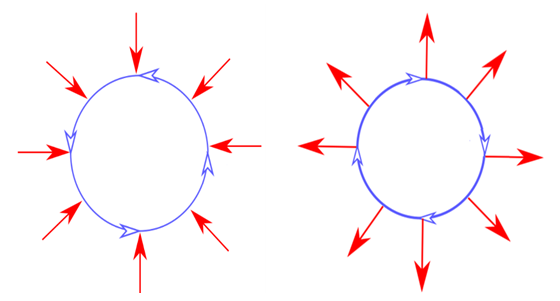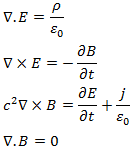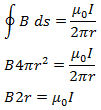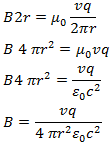-
Paper Information
- Paper Submission
-
Journal Information
- About This Journal
- Editorial Board
- Current Issue
- Archive
- Author Guidelines
- Contact Us
Energy and Power
p-ISSN: 2163-159X e-ISSN: 2163-1603
2020; 10(2): 27-30
doi:10.5923/j.ep.20201002.01

Infinite Energy Explains the Continues Behavior of Electrostatic Phenomenon Between Particles
Yehya Amari
USTHB, Algeria
Correspondence to: Yehya Amari, USTHB, Algeria.
| Email: |  |
Copyright © 2020 The Author(s). Published by Scientific & Academic Publishing.
This work is licensed under the Creative Commons Attribution International License (CC BY).
http://creativecommons.org/licenses/by/4.0/

What is known as banding energy is in fact the energy needed to separate atoms, the real banding energy is match more than this; it is the energy that holds atoms together despite the permanent vibration. This work is in continuity with previous ones that predict the same thing. This work is an analysis that ends with a proposal as a solution for the problem of energy and it sources. Characteristics of the electron (Size and Speed ...) were placed in the law of magnetic field; this led to one of most verified laws of electricity, which is the Coulomb low. Basing on this result, another real parameter which is relativity of the physical quantities was introduced by the replacement of what led to the Coulomb force. All this brought us to the conclusion that justifies the behavior of the mater, it is the existence of the Infinite Energy.
Keywords: Infinite Energy, Clean Energy, Bonding Energy
Cite this paper: Yehya Amari, Infinite Energy Explains the Continues Behavior of Electrostatic Phenomenon Between Particles, Energy and Power, Vol. 10 No. 2, 2020, pp. 27-30. doi: 10.5923/j.ep.20201002.01.
Article Outline
1. Introduction
- This work came to make a simplified continuity with the work of G. Moscariello et al. detailed in [17]. The phenomenon that historically lead to think about electricity and further the behavior of matter, is the force that attracts light bodies (dust, paper,…) to other electrically charged bodies, it is the Coulomb force [1] The question that arises in order to understand the source of this attraction from an energetic point of view is: What is the real phenomenon that results this attraction?. “The lift the paper and dust needs energy because each have a mass”. Saying that the electrostatic is the origin of this force is not a complete answer in our research, many works such as [2] [3] and [4] speaks about coulomb energy. However, from the definition of energy as a physical quantity and the way this phenomenon is happening, we can find a contradiction between the way this phenomenon happens and the quantities of energy described in. Then view the law of the electrostatic force that is not dependent on time but only three factors that will limit the amount of dust that will attach to the another charged body which are: the amount of charges, the distance and the weight. This force appears every time when the conditions are available [1]. Using an energy vision to analyze this phenomenon, we take the example where dust is attracted to a glass stick: To lift dust, the needed amount of energy is:
 | (1) |
 The number of dust seeds.
The number of dust seeds. The mass of each dust seed.
The mass of each dust seed. Gravity.
Gravity. The distance between the bar and the position of each seed of dust.Imagine that this dust will be eliminated just when he arrives at the glass stick, while for the manner by which this phenomenon occurs, another dust will take its place and so follows even if this experiment is repeated for an infinite number of times, and this is verified theoretically and experimentally.This force that pulls dust toward the glass stick is a force responsible for many phenomena that surround us, it is the force that holds atoms together in chemical molecules [5]. So far. Deepen the analysis of the experience of attracting dust to the glass bar. To give a justification with a convincing depth that allows us to have an idea about the origin of this energy responsible of moving the body. Following the experiences that satisfy the laws of electromagnetism [6], optoelectronics [7], thermodynamics [8], electrodynamics [9] [10] and quantum mechanics [11] it is clear that an electromagnetic cloud is part of the constitution of the electron. The directions of the electrostatic forces are perpendicular to the flow of electromagnetic cloud.
The distance between the bar and the position of each seed of dust.Imagine that this dust will be eliminated just when he arrives at the glass stick, while for the manner by which this phenomenon occurs, another dust will take its place and so follows even if this experiment is repeated for an infinite number of times, and this is verified theoretically and experimentally.This force that pulls dust toward the glass stick is a force responsible for many phenomena that surround us, it is the force that holds atoms together in chemical molecules [5]. So far. Deepen the analysis of the experience of attracting dust to the glass bar. To give a justification with a convincing depth that allows us to have an idea about the origin of this energy responsible of moving the body. Following the experiences that satisfy the laws of electromagnetism [6], optoelectronics [7], thermodynamics [8], electrodynamics [9] [10] and quantum mechanics [11] it is clear that an electromagnetic cloud is part of the constitution of the electron. The directions of the electrostatic forces are perpendicular to the flow of electromagnetic cloud. | Figure 1. Forces perpendicular to the flow of the EM wave |
2. Analysis Using the Lorentz Force
 | (2) |
 | (3) |
 | (4) |
3. An Analysis Using Maxwell Equations
- The content of this analysis is explained more clearly by the Maxwell equations [13]
 Taking these equations to their static state means that there is no charge variation in function of time and all charges are in their static and motionless. These equations will become [14]:
Taking these equations to their static state means that there is no charge variation in function of time and all charges are in their static and motionless. These equations will become [14]: Looking at these equations, it is found that they are separable into two distinct types from each other. They are electrostatic and magnetism. But a magnetic phenomenon also exists in these circumstances The non-existence of a movement in space which translates to speed, which in turn why: B ≠ 0. In reality, this stability is in our reference space. But what justifies this result is that the charge turns on itself in a closed-circuit which is shown clearly by the first magnetic equation:
Looking at these equations, it is found that they are separable into two distinct types from each other. They are electrostatic and magnetism. But a magnetic phenomenon also exists in these circumstances The non-existence of a movement in space which translates to speed, which in turn why: B ≠ 0. In reality, this stability is in our reference space. But what justifies this result is that the charge turns on itself in a closed-circuit which is shown clearly by the first magnetic equation:  which shows that without this current in a stable closed circuit in this reference space (does not depend on time of a macro vision) this equation will be:
which shows that without this current in a stable closed circuit in this reference space (does not depend on time of a macro vision) this equation will be:  The problem lies in the reading of this conclusion, saying that they are independent of each other doesn’t mean that each can be found single and isolated from the other, taking into account the time factor which is always present, their concept becomes clearer, they never were found separated in nature. However, in reality proven by experience, the electric force depends on the charge movement because there is no experience that was able to study a charge in its purely static state, this amounts to the impossibility of excluding the time factor at this level because it becomes an uncontrollable appearance. Taking the experimental results of the force of a charge, it is seen that the force decreases with increasing distance between the charges which means decreases with the decrease of the electrostatic field. More exactly and follows a field theory: the reduction of the field is the decrease of the influence of the physical quantity generated by the source of this quantity on influenced by this phenomenon. To understand what is really happening to give the later three points in order to provide a solid explanation for these phenomena, basing on the results of experiments, in this topic and using the deductions of the composition of particles follows certain characteristics they exhibit. Basing on the previous example and make an analogy to make an analysis on the magnetic phenomenon that accompanies this movement, basing this analysis on the basic equations governing this movement. It is known that the magnetic momentum of an atom resulting current loops of electrons and spins.
The problem lies in the reading of this conclusion, saying that they are independent of each other doesn’t mean that each can be found single and isolated from the other, taking into account the time factor which is always present, their concept becomes clearer, they never were found separated in nature. However, in reality proven by experience, the electric force depends on the charge movement because there is no experience that was able to study a charge in its purely static state, this amounts to the impossibility of excluding the time factor at this level because it becomes an uncontrollable appearance. Taking the experimental results of the force of a charge, it is seen that the force decreases with increasing distance between the charges which means decreases with the decrease of the electrostatic field. More exactly and follows a field theory: the reduction of the field is the decrease of the influence of the physical quantity generated by the source of this quantity on influenced by this phenomenon. To understand what is really happening to give the later three points in order to provide a solid explanation for these phenomena, basing on the results of experiments, in this topic and using the deductions of the composition of particles follows certain characteristics they exhibit. Basing on the previous example and make an analogy to make an analysis on the magnetic phenomenon that accompanies this movement, basing this analysis on the basic equations governing this movement. It is known that the magnetic momentum of an atom resulting current loops of electrons and spins.4. Electrostatic Force from Magnetism
- Taking one of the fundamental laws of the force acting on an electric charge moving particle known by the Lorentz law known by:
 Taking an electron with a charge which turns around itself, and then studying the magnetic force with which it acts on a charge q that is following this law this force will be given by:
Taking an electron with a charge which turns around itself, and then studying the magnetic force with which it acts on a charge q that is following this law this force will be given by: To clarify the concept, by the return to a well-known phenomenon in the field of physics that is the spin known in classical mechanics as the angular momentum of rotation. For our study, it is enough for us that this is limited to the very basic definition that states that the spin is a rotation of the particle around itself, this phenomenon for the electron creates a field of a physical quantity corresponding to a torque. This very fundamental definition is sufficient to give us proof of ownership to exploit this possibility for use in the field of renewable energy. It is very well known experimentally that the value of the magnetic field B is proportional to the current by a constant
To clarify the concept, by the return to a well-known phenomenon in the field of physics that is the spin known in classical mechanics as the angular momentum of rotation. For our study, it is enough for us that this is limited to the very basic definition that states that the spin is a rotation of the particle around itself, this phenomenon for the electron creates a field of a physical quantity corresponding to a torque. This very fundamental definition is sufficient to give us proof of ownership to exploit this possibility for use in the field of renewable energy. It is very well known experimentally that the value of the magnetic field B is proportional to the current by a constant  it is also known that this constant is of value
it is also known that this constant is of value  then the value of the magnetic field that accompanies the circulation of an electric current can be written in the following form:
then the value of the magnetic field that accompanies the circulation of an electric current can be written in the following form: Applying the latter on a spherical electric charge that revolves around itself:
Applying the latter on a spherical electric charge that revolves around itself: It is known that:
It is known that:  So:
So:  For the current of this charge that it revolves around itself [14]
For the current of this charge that it revolves around itself [14]
 The period of each turn.So the value of T is from the speed that is
The period of each turn.So the value of T is from the speed that is  and
and 
 The equation
The equation  becomes
becomes If we take that this charge is an electron. To replace the speed: For an electron, the radius is equal to:
If we take that this charge is an electron. To replace the speed: For an electron, the radius is equal to: and Zitterbewegung frequency [15] is equal to:
and Zitterbewegung frequency [15] is equal to: Then the speed will be:
Then the speed will be: By replacing on B:
By replacing on B: If this electron is interacting with another, automatically it has the same speed then:
If this electron is interacting with another, automatically it has the same speed then: Following this analysis, it is found that the magnetic force is the origin of the so-called electrostatic force. By using the two concepts known by magnetism and electricity and the combination with an example of the classical mechanics one will go out by one a simplification which helps to better understand what is going on. It has been previously seen that the force on a load under the influence of another moving charge is composed of two forces which together constitute the Lorentz force [1].
Following this analysis, it is found that the magnetic force is the origin of the so-called electrostatic force. By using the two concepts known by magnetism and electricity and the combination with an example of the classical mechanics one will go out by one a simplification which helps to better understand what is going on. It has been previously seen that the force on a load under the influence of another moving charge is composed of two forces which together constitute the Lorentz force [1]. This is analogous to a very simple example in physics.
This is analogous to a very simple example in physics.5. Relativistic Analysis
- Looking at this phenomenon with an energy-vision, we will analyse this problem using a relative vision given by relativity [14] by taking:• The electron that turns around itself “as shown above, by the speed of light c”.• The scalar nature of energy.To explain another aspect that accompanies this phenomenon. The results will be different and energy formula will be:
 And as shown previously
And as shown previously So
So The potential energy of an electronic charge relative to another is INFINITE what changes it is the trace of the existence or the operation of this remarkable energy by the value of the force applied due to the distance between the charges. This energy appears every time a charged particle enters into the field of another charged particle, despite the number of times. These results explain this behaviour. There were many works on this topic for many years, there are even contemporary works such as [16] and [17] but this one is more simple and direct. If we look to the binding energy such as described in [18] and [19] and many other works we find that they actually talk about the needed energy to separate molecules and atoms from each other, but as long as molecules and atoms are linked to each other, there is this energy to make them like they are despite the time and physical constraints.
The potential energy of an electronic charge relative to another is INFINITE what changes it is the trace of the existence or the operation of this remarkable energy by the value of the force applied due to the distance between the charges. This energy appears every time a charged particle enters into the field of another charged particle, despite the number of times. These results explain this behaviour. There were many works on this topic for many years, there are even contemporary works such as [16] and [17] but this one is more simple and direct. If we look to the binding energy such as described in [18] and [19] and many other works we find that they actually talk about the needed energy to separate molecules and atoms from each other, but as long as molecules and atoms are linked to each other, there is this energy to make them like they are despite the time and physical constraints. 6. Conclusions
- The potential energy of an electronic charge relative to another is INFINITE what changes it is the trace of the existence or the operation of this remarkable energy by the value of the force applied due to the distance between the charges. All this represents the answers to the questions and hypotheses put at the beginning, what keeps matter in permanent assembly despite the factor of time and the destabilizing phenomena is this infinite energy, it also provides us a convincing reason for the continuation of the Attraction of the dust towards the glass bar. This result can be very useful for improving the quality of human life, protection of the environment and the balance of the ecosystem and the preservation of sources of natural wealth for future generations.
 Abstract
Abstract Reference
Reference Full-Text PDF
Full-Text PDF Full-text HTML
Full-text HTML